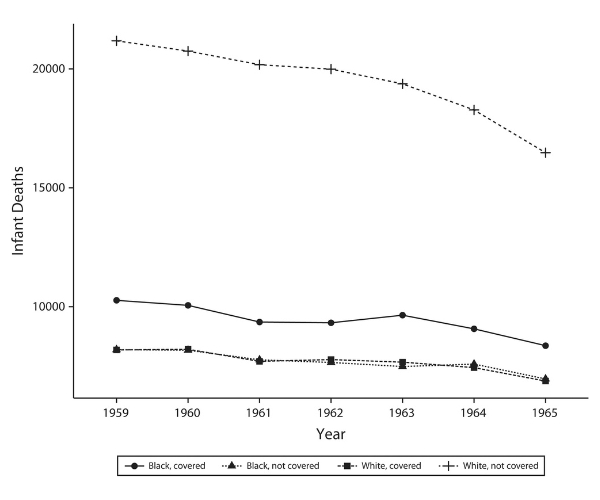Righting Wrongs with Rights
In the first five years following the Voting Rights Act of 1965, there was a 17.5% reduction in Black infant deaths in counties covered by the legislation.

Read Time: 3 minutes
Published:
The Voting Rights Act (VRA) of 1965 was a pivotal moment in American history, granting and protecting voting rights for racial minorities, especially Black Americans. The VRA banned discriminatory practices like literacy tests and required federal oversight of election changes in jurisdictions with a history of voter discrimination. New research reveals it was also a life-saving measure for thousands of Black infants in former Jim Crow states.
Rushovich and colleagues investigated the impact of VRA on infant mortality rates—defined as death before age one—among Black and White infants from 1959 to 1980. They compared counties covered by the VRA to non-covered counties. Covered counties were those with particularly egregious histories of voter suppression laws, like poll taxes, and were subject to federal intervention under the VRA. Non-covered counties, while still part of the Jim Crow South, did not have voting practices that triggered coverage under the new law.

The graph above illustrates trends in infant mortality from 1959 to 1965. It shows a surprising pattern where infant mortality rates among White infants in non-covered counties were significantly higher than those for Black infants in covered counties. This discrepancy could reflect underreporting of Black infant deaths or poor socioeconomic conditions in non-covered areas. Over time, all groups exhibit a decline in mortality rates before the VRA. However, after the VRA passed in 1965, the analysis found that Black infant mortality rates declined more sharply in covered counties. In the first five years post-VRA, there were 6,703 fewer Black infant deaths in these counties than there would have been without the legislation, a 17.5% reduction.
VRA-covered counties had a higher percentage of Black residents, lower educational attainment and incomes, greater population density and economic segregation, and fewer desegregated hospitals than non-covered counties. Despite substantial drops after 1965, Black infant mortality has remained higher than White infant mortality through the most recent period studied (2021).
The VRA’s impact on infant survival likely stemmed from the increased political power it gave Black communities. With the ability to vote, Black Americans could advocate for resources like better health care access, prenatal care, and social services that support maternal and infant health. The findings reveal how political empowerment can profoundly shape community well-being.
As the VRA’s 60th anniversary approaches, the authors emphasize the urgent need to examine how current voting policies affect health equity. The VRA’s legacy and the fight for health equity remain deeply intertwined.
Databyte via Tamara Rushovich, Rachel C. Nethery, Ariel White, and Nancy Krieger. 1965 US Voting Rights Act Impact on Black and Black Versus White Infant Death Rates in Jim Crow States, 1959–1980 and 2017–2021. American Journal of Public Health, 2023.



